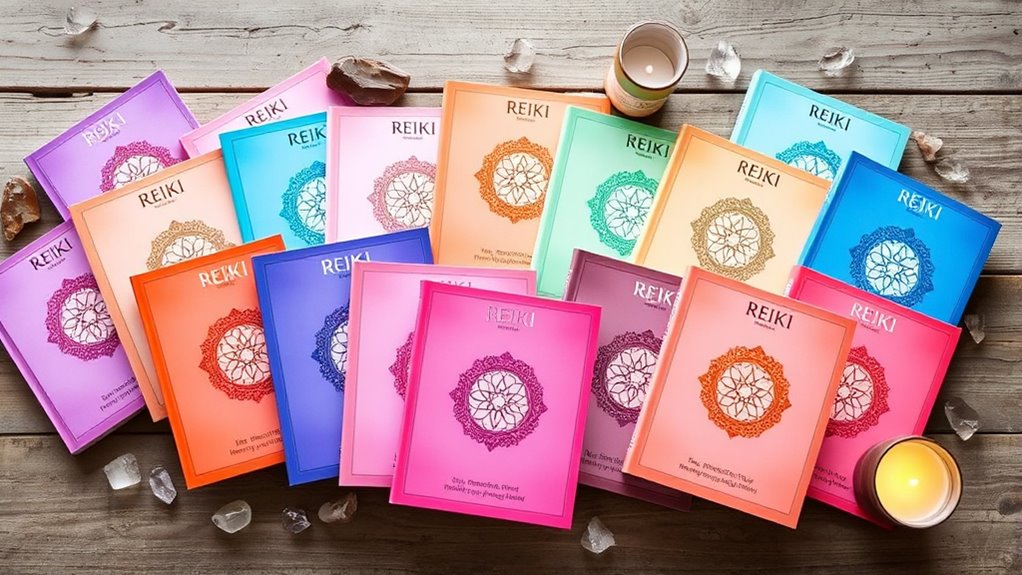If you’re looking to deepen your Reiki practice and boost your healing skills, I’ve found some of the top handbooks that guide both beginners and experienced practitioners. From traditional texts like Dr. Usui’s original guide to modern, all-encompassing manuals, these resources offer clear techniques, spiritual insights, and practical exercises. Whether you prefer visual aids, step-by-step instructions, or holistic approaches, exploring these titles can truly elevate your understanding and confidence. Keep going to discover the best options suited for your journey.
Key Takeaways
- The list includes handbooks suitable for all levels, from beginners to advanced practitioners, to deepen understanding and skills.
- It features both traditional and modern approaches, emphasizing spiritual roots, ethical practices, and practical techniques.
- Many handbooks offer visual aids, diagrams, and step-by-step instructions for effective hands-on healing.
- Several titles focus on comprehensive coverage of Reiki symbols, hand positions, and energy activation methods.
- The selection highlights books with positive reviews, authentic content, and suitability for ongoing practice and mastery.
The Original Reiki Handbook of Dr. Mikao Usui
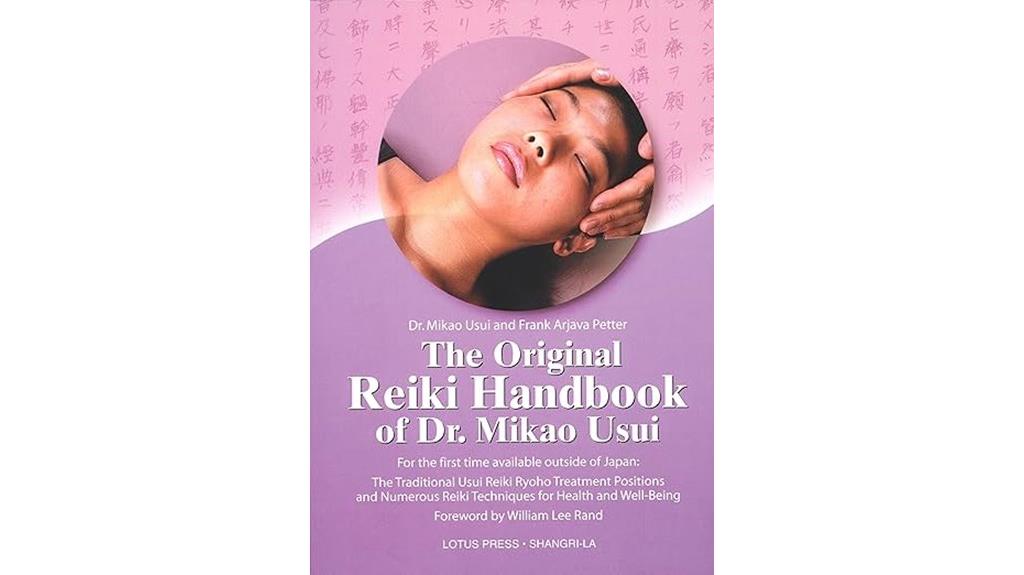
Are you seeking an authentic and detailed resource to deepen your understanding of Reiki’s origins and core techniques? The Original Reiki Handbook of Dr. Mikao Usui is exactly that. Authored by Frank Arjava Petter, based on original Japanese materials translated by Christine Grimm, it offers a thorough look into Usui’s teachings. You’ll find clear explanations of essential concepts, detailed hand positions with photographs, and insights into Reiki’s Buddhist roots. This manual is practical for beginners and experienced practitioners alike, emphasizing authentic techniques and the spiritual foundation of Reiki. It’s a valuable, reliable guide to deepen your practice and honor its true lineage.
Best For: practitioners and students seeking an authentic, detailed, and historically grounded resource to deepen their understanding of Reiki’s origins, techniques, and spiritual foundation.
Pros:
- Comprehensive coverage of traditional Reiki concepts with clear explanations and illustrations
- Includes authentic hand positions and photographs for practical application
- Emphasizes the spiritual and Buddhist roots of Reiki, providing a profound understanding of its lineage
Cons:
- May be dense for absolute beginners without prior exposure to Reiki principles
- Focuses heavily on traditional practices, which might differ from modern Western adaptations
- Limited focus on advanced or modern Reiki techniques outside the core teachings
Reiki Handbook for Students and Therapists
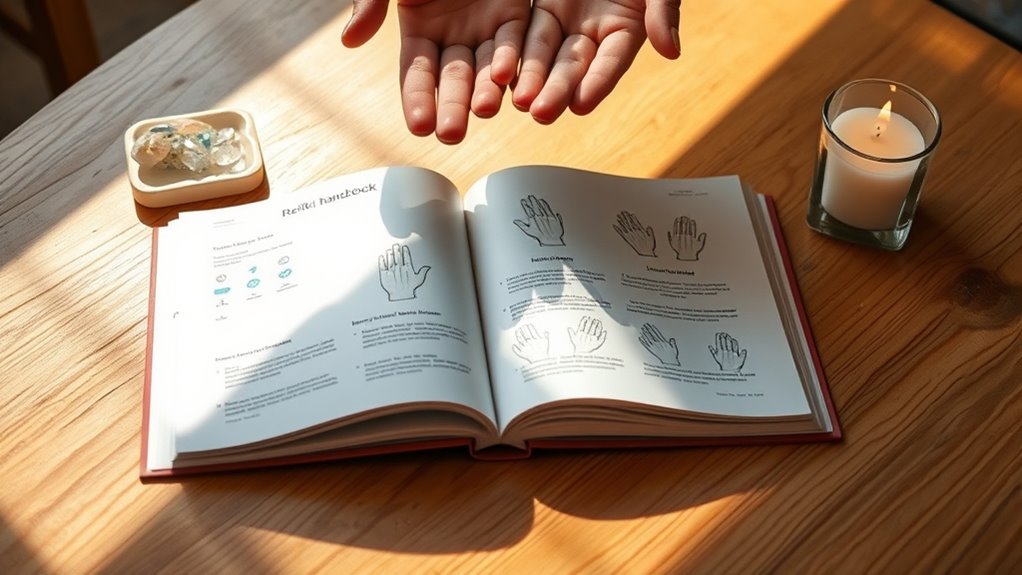
If you’re new to Reiki and seeking a straightforward, practical guide, the “Reiki Handbook for Students and Therapists” is an excellent choice. It offers clear instructions on hand positions, treatment guidelines, and visual diagrams, making it ideal for beginners. The book includes helpful notes sections for personal reference and covers applications for animals. It emphasizes professional boundaries and ethical practice, ensuring safe and respectful sessions. While it contains some historical inaccuracies and legends, many practitioners value its extensive coverage and personal touches, like signed blessings. Overall, it’s a solid foundation for students and a useful reference for therapists.
Best For: beginners seeking a practical, easy-to-follow Reiki manual with visual aids and ethical guidance.
Pros:
- Clear instructions and visual diagrams suitable for newcomers
- Emphasizes professional boundaries and ethical practice
- Personal touches like signed blessings enhance spiritual value
Cons:
- Contains some historical inaccuracies and legends about Reiki origins
- Lacks detailed images of arm and leg hand positions
- Higher price point may be a concern for some learners
Essential Reiki: A Complete Guide to an Ancient Healing Art
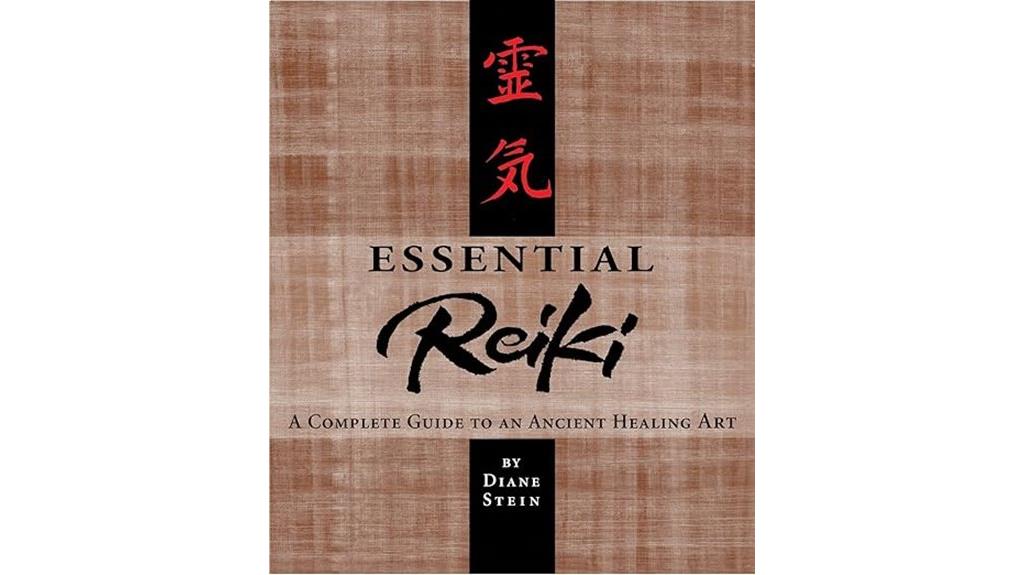
Looking for a thorough, accessible guide that demystifies Reiki? Essential Reiki by Diane Stein is exactly that. It offers clear explanations of methods, symbols, and history, making it perfect for beginners and experienced practitioners alike. Stein emphasizes open sharing of healing energy, challenging traditional secrecy, and promoting universal accessibility. Her practical instructions, illustrations, and personal insights help deepen your practice, whether for self-healing or attuning others. Despite some controversy, many find this book empowering and invaluable for expanding their Reiki skills. It’s a complete resource that encourages a loving, inclusive approach to healing, making Reiki more approachable for everyone.
Best For: beginners and experienced Reiki practitioners seeking a comprehensive, accessible, and open approach to learning and sharing Reiki energy.
Pros:
- Clear explanations and practical guidance suitable for all levels
- Promotes open sharing of symbols and healing energy, fostering inclusivity
- Includes detailed instructions, illustrations, and personal insights for deepening practice
Cons:
- May challenge traditional views on secrecy, leading to controversy among some practitioners
- Not a substitute for formal attunement or certification
- Some readers may disagree with Stein’s feminist and Wiccan perspectives influencing the tone
The Reiki Manual: A Training Guide for Reiki Students, Practitioners, and Masters
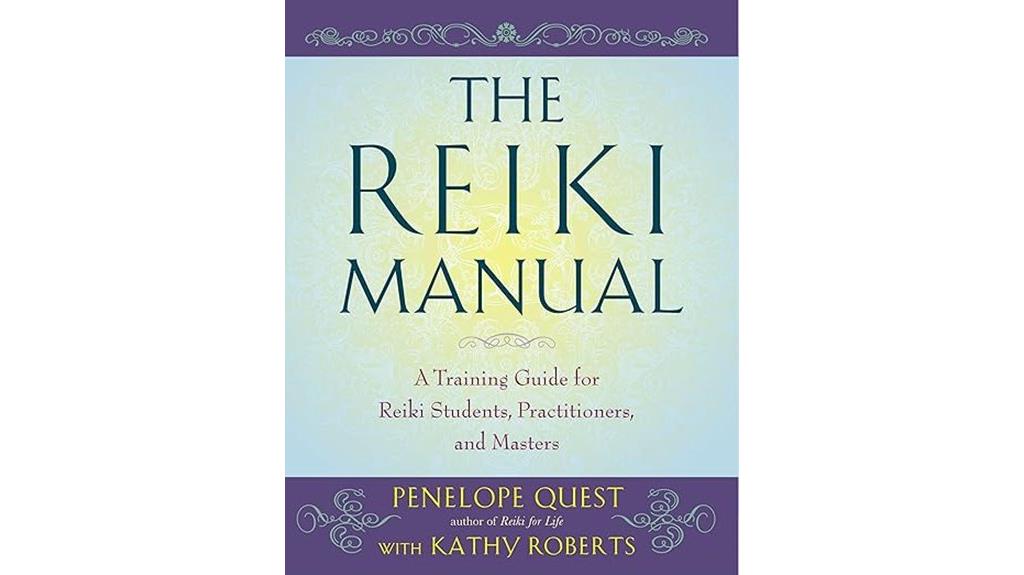
The Reiki Manual: A Training Guide for Reiki Students, Practitioners, and Masters stands out as an ideal resource for both beginners and experienced practitioners seeking extensive, easy-to-understand guidance. I find it highly valued for its clear explanations, all-encompassing coverage, and practical approach. It details all Reiki levels, techniques, hand positions, and symbols, with illustrations and activities that reinforce learning. Its workbook structure makes self-assessment straightforward, and the inclusion of insights on running a Reiki practice adds depth. Many users, including teachers and students, consider it their go-to manual for training, review, and ongoing reference—making it a versatile and trusted tool in the Reiki community.
Best For: beginners and experienced Reiki practitioners seeking a comprehensive, clear, and practical training manual that covers all levels and techniques.
Pros:
- Highly regarded for its clarity and well-written explanations, making complex concepts accessible
- Includes detailed illustrations, diagrams, and activities to reinforce learning and self-assessment
- Covers all Reiki levels, techniques, symbols, and practical tips, making it a versatile reference
Cons:
- Being UK-based, some legal and practice references may not directly apply outside the UK, particularly in the US
- Does not display glyphs of symbols, which may require supplementary visual resources for some learners
- The focus on UK practices might limit its applicability for practitioners seeking a more international perspective
The Reiki Handbook Beginner to Master Level
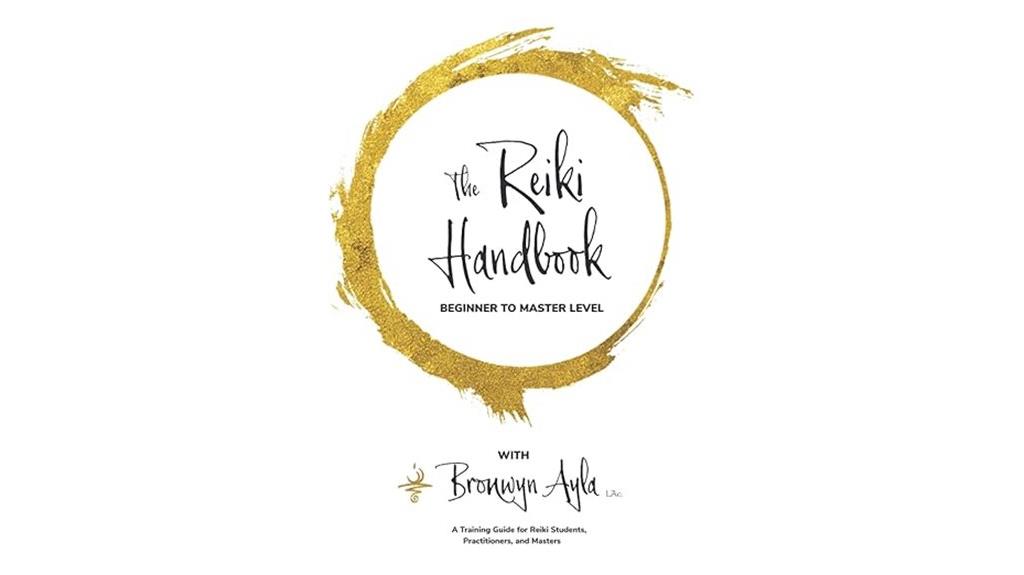
The Reiki Handbook Beginner to Master Level stands out as an ideal resource for both students just starting their journey and experienced teachers seeking a complete reference. I find its depth, clarity, and approachable tone highly valuable, blending insights from Reiki, Traditional Chinese Medicine, and Yoga. The full-color format and peaceful presentation make learning enjoyable and calming. As someone who’s taken Reiki Levels 1 and 2, I appreciate how this book enhances understanding and confidence, especially in practical skills like generating light at my light station. Although the Kindle version has some formatting issues, the physical copy remains a trusted, spiritually uplifting guide I highly recommend for all levels.
Best For: Reiki students and teachers seeking a comprehensive, accessible manual that combines spiritual and practical insights with an emphasis on clarity and calming presentation.
Pros:
- Highly detailed and thorough coverage of Reiki principles, techniques, and integration with Traditional Chinese Medicine and Yoga.
- Beautiful full-color format and peaceful tone that enhance learning enjoyment and relaxation.
- Clear, straightforward language that builds confidence and practical skills, making it suitable for beginners and experienced practitioners alike.
Cons:
- Kindle version has formatting issues, such as sideways pages and tiny text, that hinder readability.
- Digital format requires proper reformatting to be user-friendly on e-readers, currently making it less accessible electronically.
- The physical book’s quality and presentation are highly praised, but the digital version is less convenient for on-the-go reading.
Reiki: The Healing Touch – First and Second Degree Manual
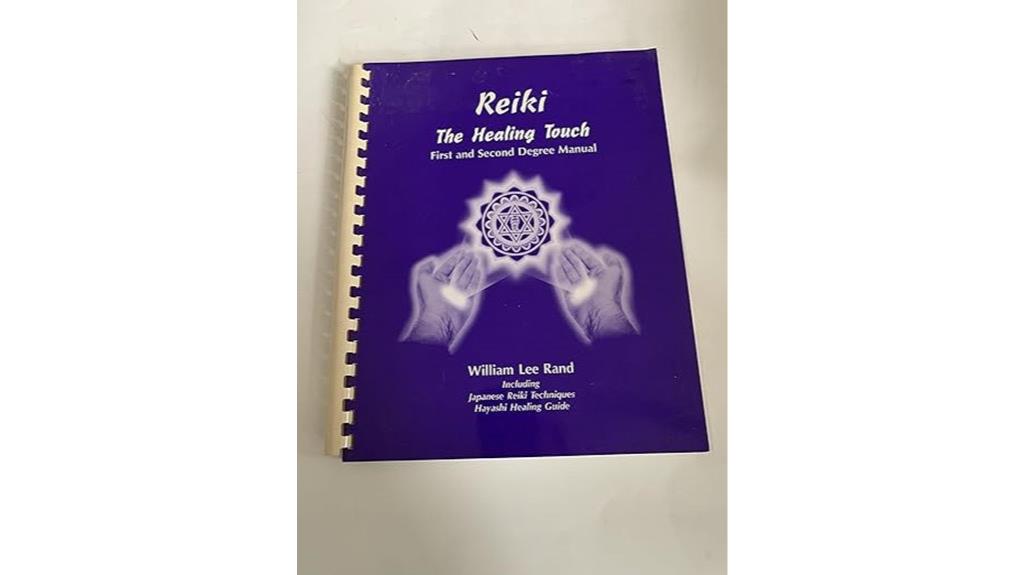
If you’re a Reiki student seeking a clear, all-encompassing guide to both first and second-degree practices, “Reiki: The Healing Touch – First and Second Degree Manual” is an excellent choice. Authored by Reiki Master William Rand and endorsed by the International Center for Reiki Training, it offers logical, straightforward coverage of essential techniques, symbols, and spiritual aspects. The manual is praised for its clarity, making complex concepts accessible for beginners and advanced students alike. While it doesn’t include symbols directly, it provides a solid foundation for practice and spiritual development. Many users find it indispensable for reference and building confidence in their Reiki journey.
Best For: Reiki students of all levels seeking a clear, comprehensive guide to both first and second-degree practices, symbols, and spiritual development.
Pros:
- Highly regarded for clarity, logical structure, and comprehensive coverage of essential Reiki techniques and concepts.
- Endorsed by the International Center for Reiki Training and authored by experienced Reiki Master William Rand, ensuring credibility.
- Suitable for both beginners and advanced practitioners, serving as a reliable reference and foundational resource.
Cons:
- Does not include Reiki symbols directly, requiring supplementary materials for symbol practice.
- Some users suggest updates to include recent research, advanced topics, and newer practices like distance Reiki.
- It is a student manual, not a teacher’s manual, which may limit detailed instructional content for teaching others.
Reiki Illustrated: Visual Guide of Hand Positions, Symbols, and Treatment Sequences
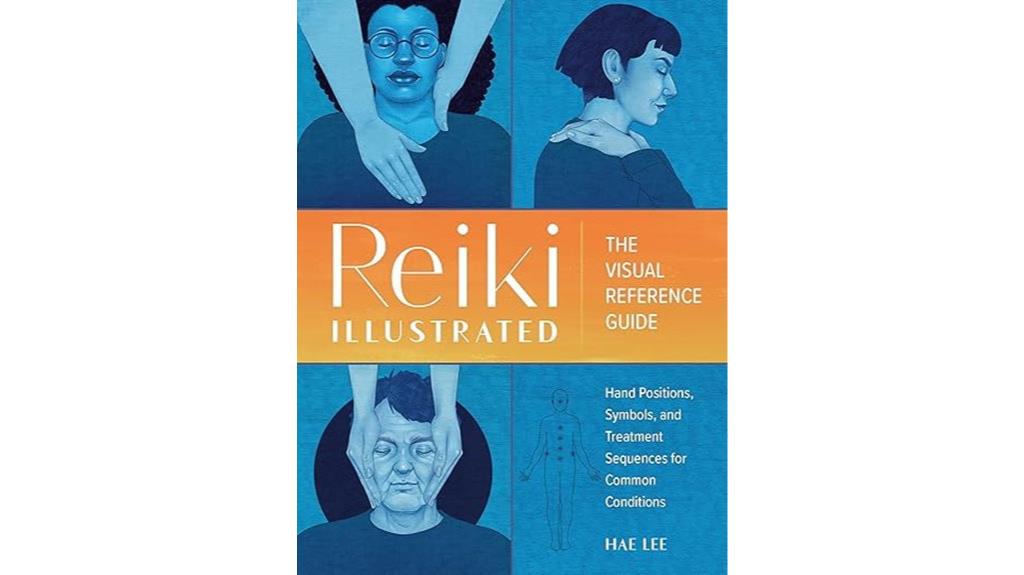
For anyone seeking a clear and practical visual reference, “Reiki Illustrated” stands out as an ideal guide. Its simple, detailed illustrations of hand positions, symbols, and treatment sequences make complex concepts easy to understand. I appreciate how the visuals are digestible and well-organized, making it perfect for quick consultation during practice or on the go. The book covers both in-person and distance healing techniques, providing step-by-step guidance that’s accessible for beginners and enriching for experienced practitioners. Overall, it’s a valuable resource that enhances confidence, deepens understanding, and supports ongoing growth in my Reiki journey.
Best For: beginners and experienced Reiki practitioners seeking a clear, visual reference to hand positions, symbols, and treatment sequences for both in-person and distance healing.
Pros:
- Highly detailed and easy-to-understand illustrations that facilitate quick reference and practice.
- Covers a comprehensive range of techniques, including specific physical and emotional healing methods.
- Suitable for all levels, from beginners to seasoned practitioners, supporting ongoing growth and confidence.
Cons:
- May lack in-depth theoretical explanations for those seeking a more academic understanding.
- Some users might prefer more advanced or specialized content beyond the basic visual guides.
- The focus on visuals might not fully satisfy practitioners looking for detailed textual guidance or background information.
The Complete Reiki Handbook

Wondering which Reiki handbook is perfect for beginners and early practitioners? “The Complete Reiki Handbook” by Walter Lubeck is an excellent choice. This 192-page guide offers a thorough introduction to Reiki, emphasizing the concept of “Reiki-Do,” or “Universal healing way.” It covers traditional techniques, hand positions, chakra work, and holistic practices like crystals, scents, and meditation. The book provides detailed illustrations, treatment indexes, and practical advice for treating various ailments. Lubeck’s approach centers on inner empowerment and self-healing, making it a solid foundational resource. It’s especially helpful for those starting out or practicing at levels 1 and 2.
Best For: beginners and early-level Reiki practitioners seeking a practical, comprehensive introduction to traditional healing techniques and holistic practices.
Pros:
- Provides clear hand positions and treatment techniques with detailed illustrations
- Emphasizes inner empowerment and self-healing, aligning with holistic philosophies
- Includes practical guidance on treating a variety of ailments and integrating additional healing modalities
Cons:
- Contains depictions of nudity which some may find inappropriate or disrespectful
- Focuses mainly on levels 1 and 2, offering limited information on advanced practices
- The cost of certification and advanced training can be high and may deter some learners
Reiki for Life (Updated Edition): Complete Guide to Reiki Practice Levels 1-3
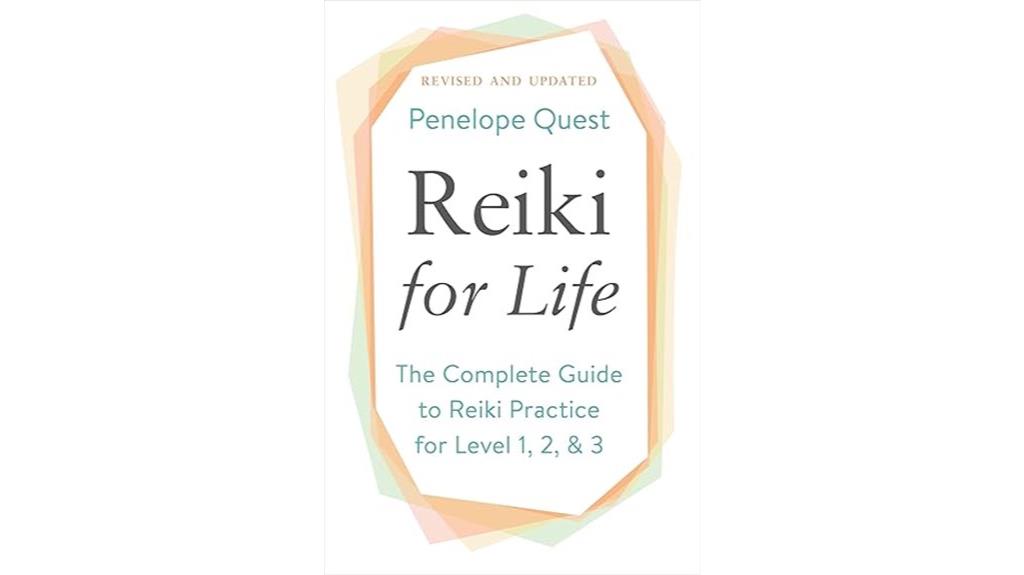
Reiki for Life (Updated Edition) stands out as an ideal guide for beginners and those progressing through Reiki levels who want a clear, all-encompassing resource. I found it to be thorough yet accessible, with detailed instructions, illustrations, and explanations of techniques, symbols, and hand positions. The book covers Reiki energy, levels 1-3, ongoing practice, and Japanese traditions, making it perfect for self-study or reference. Its balanced approach helps deepen understanding without overwhelming, clarifying misconceptions and highlighting differences between Western and Japanese practices. If you’re looking to strengthen your Reiki foundation or explore advanced concepts, this book is a valuable, practical companion.
Best For: beginners and advanced Reiki practitioners seeking a comprehensive, clear, and practical guide to deepen their understanding and practice of Reiki levels 1-3.
Pros:
- Well-organized with detailed instructions, illustrations, and explanations suitable for self-study and reference.
- Balances thoroughness with accessible language, avoiding unnecessary spiritual jargon.
- Provides valuable insights into both Western and Japanese Reiki traditions, enhancing cultural understanding.
Cons:
- Lacks personal anecdotes or experiential stories that some readers look for in a spiritual guide.
- Some critiques about historical claims regarding Usui and the oversimplification of mastery requirements.
- Not a substitute for hands-on training or attunements, so practical application still depends on formal practice sessions.
Reiki Healing for Beginners: Step-by-Step Guide
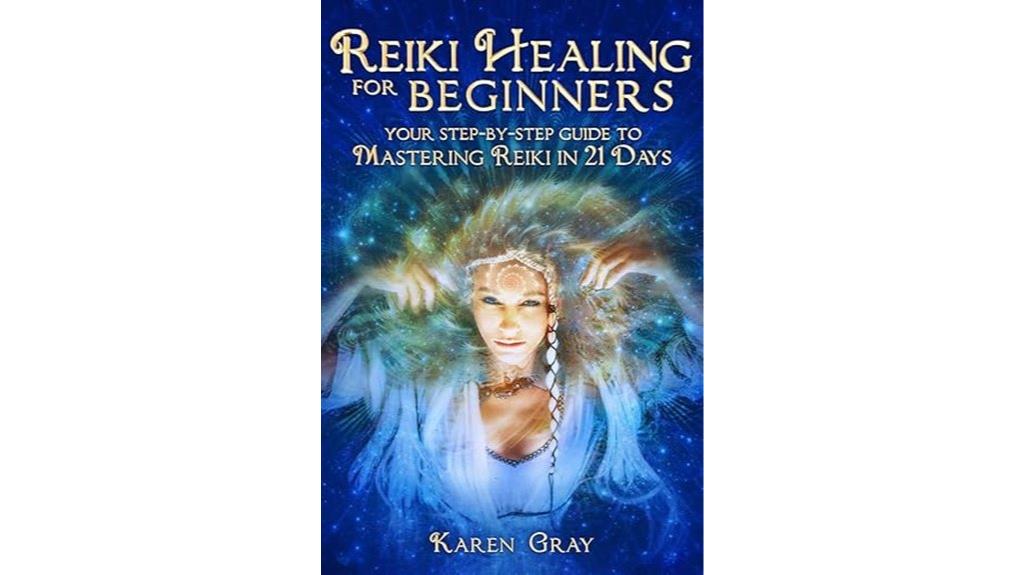
This step-by-step guide is ideal for beginners enthusiastic to explore Reiki without feeling overwhelmed. I appreciate how it’s structured to build confidence over 21 days, breaking down techniques clearly and systematically. The book covers both basic and advanced concepts, making it accessible regardless of prior knowledge. I found the inclusion of affirmations, meditation tips, and resource links especially helpful for supporting my practice. Its concise format and practical guidance made learning enjoyable and manageable. Whether you’re seeking self-care or healing skills, this guide reassures you that Reiki is a skill anyone can develop, fostering confidence and a deeper connection to energy healing.
Best For: Beginners eager to explore Reiki confidently and systematically over 21 days, seeking clear guidance and practical techniques for self-care and healing.
Pros:
- Structured 21-day approach builds confidence gradually and systematically
- Includes affirmations, meditation tips, and resource links for comprehensive support
- Concise and easy-to-understand format suitable for newcomers and those seeking self-healing
Cons:
- May not provide enough depth for advanced Reiki practitioners
- Some users might find the brief format limiting for more detailed study
- Not specifically tailored for professional or in-depth Reiki training beyond basic concepts
Reiki Healing Handbook: How to Activate Energy Healing

If you’re new to energy healing or seeking a clear, practical guide to activate Reiki, the “Reiki Healing Handbook” stands out as an ideal resource. It walks you through activating energy healing with simple steps like setting the mood with candles and music, focusing on the first Reiki symbol, and working on the heart chakra. I personally found that using palm placements, visualization, and intention created a powerful energy release that brought me peace and clarity. The book’s intuitive guidance, combined with detailed illustrations and step-by-step instructions, makes it easy to confidently activate Reiki energy and deepen your healing practice. Active, mindful practice is key to experiencing its full benefits.
Best For: Beginners and experienced energy healers seeking a clear, practical, and accessible guide to activate and deepen their Reiki practice.
Pros:
- Well-organized with detailed explanations and helpful illustrations that facilitate correct practice
- Emphasizes core principles and meditative techniques that support spiritual growth and emotional healing
- Supports both self-healing and distant healing, making it versatile for various needs
Cons:
- May require additional training or guidance from a Reiki master for advanced techniques
- Some users might find the focus on beginner steps less detailed for experienced practitioners
- The emphasis on setting mood with candles and music might not suit all environments or preferences
Chakra Healing: Beginner’s Guide to Self-Healing Techniques
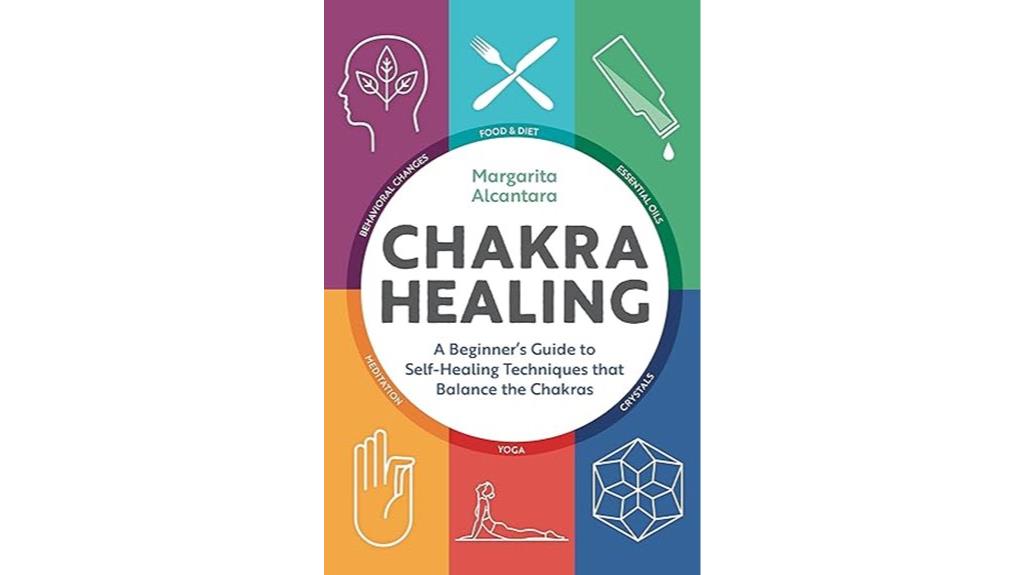
Are you new to energy healing and curious about how to start balancing your chakras? “Chakra Healing: Beginner’s Guide to Self-Healing Techniques” is an ideal resource for anyone seeking a straightforward introduction to chakra work. This book offers clear explanations of chakras, their locations, and emotional significance, making complex concepts accessible. It includes practical techniques like meditation, visualization, breathing exercises, and yoga poses that are easy to follow. Plus, it highlights tools such as crystals and essential oils for balancing energies. Designed for beginners and skeptics alike, it encourages gentle progress and self-awareness, helping you deepen your healing journey with confidence.
Best For: Beginners and skeptics interested in gentle, accessible methods to understand and balance their chakras and energy systems.
Pros:
- Clear and easy-to-understand explanations suitable for newcomers.
- Incorporates practical techniques like meditation, visualization, and yoga poses.
- Offers tools such as crystals and essential oils with guidance on their use.
Cons:
- Some readers find the content to be somewhat light or lacking in depth.
- May require additional resources for more advanced chakra work.
- Focuses primarily on introductory concepts, which might not satisfy experienced practitioners.
Essential Reiki Teaching Manual: A Companion Guide for Reiki Healers

The Essential Reiki Teaching Manual by Diane Stein stands out as an ideal resource for Reiki teachers and students seeking a thorough, easy-to-understand guide. I find it invaluable for teaching Reiki levels 1, 2, and 3, thanks to its clear explanations and practical handouts. Stein’s approachable style makes complex concepts accessible, whether you’re a beginner or advanced practitioner. The book’s detailed techniques and symbols support effective instruction, and many users, including myself, rely on it as a primary teaching tool. While some wish for digital resources, its holistic content makes it a trusted, go-to manual for deepening your Reiki practice and sharing your knowledge.
Best For: Reiki teachers and students seeking a comprehensive, easy-to-understand manual to deepen their practice and enhance their teaching skills.
Pros:
- Clear, detailed explanations suitable for all experience levels
- Practical handouts and symbols that support effective teaching and learning
- Highly regarded as a reliable, well-written resource within the Reiki community
Cons:
- Lacks digital resources such as PDFs or downloadable images for easier access
- Some users find that its organization could be improved with clearer outlines or perforated pages
- Occasional mentions of gender bias in the author’s perspective, which some readers choose to overlook
Crystal Reiki: A Handbook for Healing Mind, Body, and Soul

Crystal Reiki: A Handbook for Healing Mind, Body, and Soul stands out as an ideal resource for beginners and those curious about combining crystals with Reiki. I find it offers practical guidance on integrating crystals into healing routines, focusing on chakras and energy work. While it’s simple, accessible, and visually appealing, it’s not overly complex, making it perfect for quick reference. I appreciate Krista Mitchell’s genuine insights and real-life tips, which help deepen understanding without overwhelming. Although some may wish for more visuals and better organization, this book remains a valuable, easy-to-use tool for anyone exploring holistic healing through crystal Reiki.
Best For: beginners and curious individuals interested in integrating crystals with Reiki for holistic healing and energy work.
Pros:
- Simple and accessible language suitable for beginners.
- Beautiful artwork and visuals that enhance understanding and visualization.
- Practical tips and real-life insights for effective application of crystal Reiki.
Cons:
- Limited in-depth content, not ideal for advanced practitioners.
- Some readers find the organization and layout could be improved for easier navigation.
- Lacks comprehensive visuals and illustrations, which could aid further understanding.
Light on the Origins of Reiki: A Handbook for Practicing the Original Reiki of Usui and Hayashi
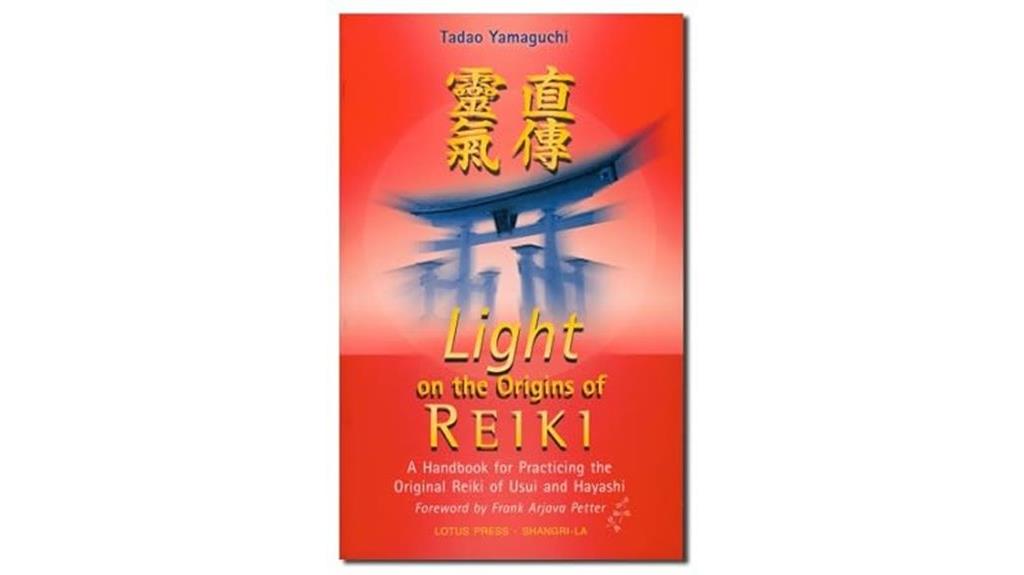
If you’re seeking an authentic understanding of Reiki’s roots, “Light on the Origins of Reiki” is an invaluable resource. It explores the Japanese origins of Reiki, highlighting teachings from Dr. Mikao Usui and Hayashi Sensei. The book offers rare historical insights, photographs, and stories from the Yamaguchi family, emphasizing traditional Japanese practices. It clarifies misconceptions and compares Western and Japanese Reiki, stressing the importance of maintaining authentic methods. With detailed explanations of core concepts like byosen and the significance of cultural context, this handbook helps practitioners deepen their connection to Reiki’s true origins and preserve its original essence.
Best For: practitioners and enthusiasts seeking an authentic, historically grounded understanding of Japanese Reiki, its origins, and traditional practices.
Pros:
- Provides in-depth historical context and authentic insights from Japanese masters and families.
- Includes rare photographs, stories, and explanations that enhance understanding of original Reiki methods.
- Clarifies misconceptions and highlights cultural differences between Western and Japanese Reiki practices.
Cons:
- Focuses heavily on history and anecdotes, with less detailed technical guidance on practice techniques.
- Some readers may find the content more suited for cultural and historical interest rather than practical step-by-step instructions.
- Scientific explanations, such as concepts like byosen, may require further clarification from specialized sources.
Factors to Consider When Choosing a Reiki Handbook

When selecting a Reiki handbook, I focus on the authenticity of the content and the expertise of the author to guarantee I’m learning from reliable sources. I also look for clear visuals and practical instructions that make practicing easier, along with accurate historical information to deepen my understanding. Considering these factors helps me choose a book that truly supports my growth as a practitioner.
Content Authenticity
Choosing a reputable Reiki handbook requires ensuring that the content is authentic and rooted in credible sources. I look for manuals based on original or well-researched historical materials, which helps verify the accuracy of the teachings. It’s important that the handbook references authentic Japanese Reiki practices or traditions, as this indicates alignment with the original lineage. I also check if the book clearly differentiates between various Reiki lineages and explains any cultural or stylistic differences. Endorsements or reviews from respected Reiki practitioners or scholars further validate the content’s reliability. Additionally, I seek detailed explanations of techniques, symbols, and principles that are consistent with established authentic practices. These factors help me trust that the handbook provides genuine, accurate guidance to deepen my practice.
Author Expertise
How can you determine if a Reiki handbook is written by a truly knowledgeable author? Look at their background—authors with real experience in Reiki, holistic healing, or related fields show they understand the practice deeply. Check their credentials, such as Reiki master certifications or training in traditional Japanese methods, which add credibility. An author with a history of teaching, research, or publishing demonstrates a solid grasp of Reiki principles. If they also have experience in healing modalities like Chinese medicine or energy work, it enriches their perspective. Additionally, contributions like workshops, seminars, or mentorships reveal recognized expertise. These indicators help guarantee you’re learning from someone who truly understands Reiki and can guide you effectively on your healing journey.
Visual Clarity
A clear and visually well-designed handbook makes learning Reiki much easier by providing accurate and easy-to-understand images of hand positions, symbols, and treatment steps. Well-illustrated manuals use diagrams, photographs, or artwork that accurately depict techniques, reducing the risk of misinterpretation. Visual clarity helps me quickly locate specific positions or symbols during practice, boosting my confidence and efficiency. High-quality visuals that are easy to discern support different learning styles, especially visual learners like myself. Consistent and organized imagery allows for easy comparison between techniques, which improves retention and mastery. When choosing a Reiki handbook, I prioritize clear visuals that enhance understanding and make practicing more straightforward. This focus on visual clarity ultimately helps me deepen my practice with greater accuracy and confidence.
Practical Instructions
When selecting a Reiki handbook, I look for clear, step-by-step practical instructions that guide me through hand positions, treatment sequences, and energy techniques. It’s essential that the manual includes visual aids like diagrams or photographs to help me accurately locate hand placements and understand the flow of treatments. I also prioritize instructions that address both touching and non-touching methods, so I can adapt to different client needs and settings. A good handbook provides detailed guidance for treating specific ailments, making my practice more targeted and effective. Additionally, I value tips on maintaining ethical boundaries, setting clear intentions, and applying Reiki principles during sessions. These practical instructions ensure I practice safely, confidently, and with purpose.
Historical Accuracy
Choosing a Reiki handbook that accurately reflects its origins helps guarantee I’m practicing authentically and ethically. I look for sources grounded in reputable historical records or original teachings, which help verify the accuracy of its account of Reiki’s beginnings. Cross-referencing content with authentic texts or testimonies from recognized authorities ensures I’m not misled by myths or misconceptions. An excellent handbook should depict the cultural context and traditional practices from Mikao Usui’s era and early Japanese Reiki masters. Recognizing the differences between Western adaptations and original Japanese practices is essential for understanding the true lineage. Including references such as photographs, original texts, or credible testimonies boosts a handbook’s credibility and helps me connect more deeply with Reiki’s authentic history.
Accessibility Level
Ever wondered how easily you can follow a Reiki handbook? Accessibility is vital for a smooth learning experience. A good manual uses clear, simple language, making it easy for beginners or those with limited energy healing background to understand. Visual aids like diagrams and photographs are essential—they help clarify hand positions, symbols, and techniques. The content should be organized logically, with step-by-step instructions that build from basic concepts to more advanced practices. A user-friendly layout—large print, clear headings, and notes sections—makes navigation effortless and quick referencing simple. Most importantly, a highly accessible handbook avoids technical jargon and assumes no prior knowledge, ensuring it’s inclusive for diverse learning styles and skill levels.
Supplementary Resources
Have you considered how supplementary resources can deepen your understanding of Reiki? These extras—videos, online courses, PDFs—enhance the concepts in your handbook by offering practical demonstrations and varied learning formats. Many extensive manuals recommend or include access to guided meditations, symbol charts, or practice exercises that reinforce your skills. Digital platforms and apps provide interactive tutorials, step-by-step guidance, and remote learning options, making it easier to practice consistently. These resources help clarify complex techniques, offer visual cues, and support retention through repetition. When choosing a Reiki handbook, look for those that recommend or include access to such supplementary tools. They can profoundly boost your ongoing education, deepen your practice, and help you achieve mastery more effectively.
Price and Value
When selecting a Reiki handbook, it’s essential to take into account its price in relation to the value it offers. I look for books that strike a balance between thorough content and affordability, ensuring the material justifies the cost. Quality and depth matter; a more expensive handbook often provides exclusive insights, detailed illustrations, or additional resources that enhance my learning experience. I also consider whether the price fits my budget and if the book will serve as a useful long-term reference. Investing in a well-reviewed, reputable handbook tends to deliver better educational value and durability compared to cheaper, less detailed options. Ultimately, I aim for a resource that offers meaningful knowledge and practical application, making the investment worthwhile for my ongoing practice.
Frequently Asked Questions
How Do I Choose the Best Reiki Handbook for My Skill Level?
To choose the best Reiki handbook for my skill level, I look for one that matches my experience. Beginners should start with clear, simple guides that explain fundamentals, while advanced practitioners benefit from in-depth texts covering complex techniques. I also check reviews and author credentials to confirm credibility. Ultimately, I pick a book that resonates with me, offers practical exercises, and encourages my growth at my current level.
Are There Specific Hand Positions Recommended for Emotional Healing?
Yes, there are specific hand positions for emotional healing. I recommend placing your hands gently on the heart center, solar plexus, or throat chakra to promote emotional release and balance. Focus on soft, intuitive touch rather than rigid placement. Trust your instincts, and remember that emotional healing often involves connecting with what your client needs most. Your intuition and compassion are your best guides in choosing the right positions.
Can Reiki Handbooks Be Used as Standalone Learning Resources?
Yes, Reiki handbooks can be used as standalone learning resources. I’ve found them incredibly helpful for understanding techniques, principles, and self-practice without needing additional courses. They offer detailed guidance and insight that lets me deepen my skills at my own pace. However, I also recommend combining reading with hands-on practice and mentorship for the most effective learning experience.
How Often Should I Review My Reiki Handbook to Deepen Practice?
Think of your Reiki handbook as a trusted map that guides your healing journey. I review mine regularly, about once a month, to deepen my understanding and refine my skills. Sometimes, I revisit specific sections when I encounter new challenges or feel stuck. This consistent review keeps my practice fresh and connected, like tending a garden—nurturing growth and ensuring my healing skills stay vibrant and effective.
Do Different Authors’ Handbooks Present Conflicting Techniques?
Yes, different authors can present conflicting techniques in their handbooks. I’ve noticed variations in hand placements, symbols, and healing approaches, which can be confusing at first. I recommend exploring multiple sources but trusting your intuition to find what resonates most. Ultimately, your personal experience and practice will help you adapt and refine techniques that work best for you, regardless of differing methods from various authors.
Conclusion
Choosing the right Reiki handbook can truly deepen your practice. I remember a student who, after reading *The Reiki Manual*, gained confidence and healed a persistent shoulder tension. Like her, you’ll find that the right guide not only enhances your skills but also opens new doors to healing and self-discovery. So, explore these options, trust your intuition, and watch your practice flourish. Your healing journey is just a page away.
